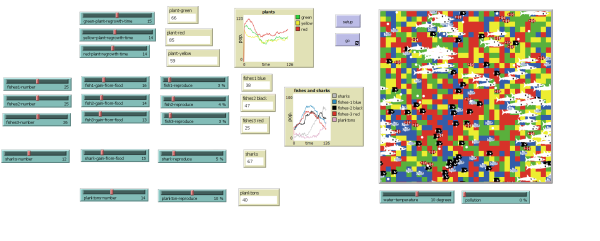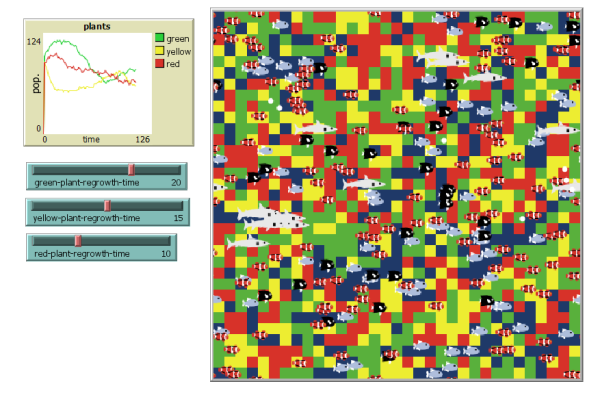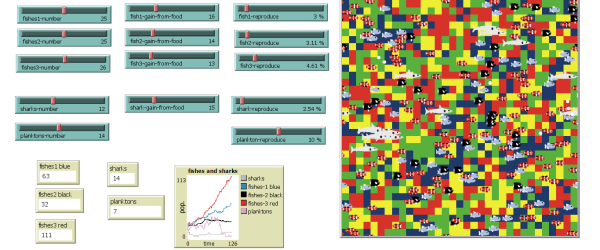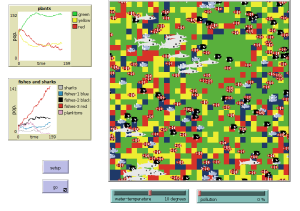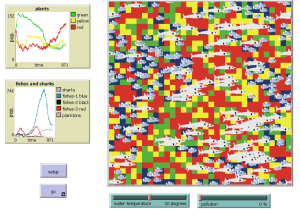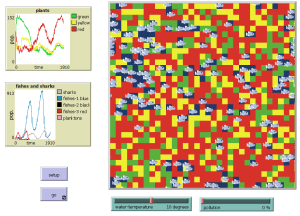Aquatic ecosystem simulation
Title: Aquatic ecosystem simulation
Author: Daria Tutynina
Method: Agent-based model
Tool: NetLogo
Contents
Introduction and problem definition
This simulation aims to replicate, in a simplified form, the intricate dynamics of marine life in the Pacific Ocean based on real-world scientific data. While the simulation is not an exact replica due to the immense complexity of marine ecosystems, it serves as a representative model. The focus lies on food webs, and interactions between species within the ecosystem. The primary goal is to explore how different changes can impact marine populations.
Environment
The foundational environment of the simulation consists of a vibrant blue water body, hosting a diverse ecosystem of our agents. Within this aquatic realm, three distinct varieties of plants thrive, each represented by a different color.
to setup-ocean set ocean-color blue - 2 set green-plant-regrowth-time 20 set yellow-plant-regrowth-time 15 set red-plant-regrowth-time 10 ...
Green color (Spirulina)
The green color symbolizes spirulina, a microscopic cyanobacterium abundant in the water. This type of plant serves as a primary food source for a large portion of the fish population. Due to its rapid growth, spirulina provides a consistent and plentiful supply of sustenance for the aquatic organisms.
Yellow color (Coral Reefs)
The yellow color represents a highly specific type of plant, resembling coral reefs in the real world. These plants cater to a particular species of fish with a specialized diet. For instance, they might simulate the ecological role of coral species that grow at a moderate pace, offering sustenance to a specific type of fish adapted to this unique environment.
Red Color (Lemnaceae - Coffee Bean Plant)
The red color signifies plants that grow at a slower rate. These plants are consumed by fish with a mixed dietary preference.
Agents
- Fishes: Inspired by real Pacific Ocean species, each with specific traits such as energy levels, reproduction rates, and movement patterns. In this simulation, three distinct types of fish are introduced, each representing different fish families: fish1 (blue), fish2 (black), and fish3 (red). Each type is associated with different feeding strategies, reflecting various fish families.
The first type, fish1 (blue), represents Generalist Herbivores. These fish have a broader dietary spectrum and can consume a wide variety of different plant species. Their feeding behavior is characterized by the ability to adapt to and consume various types of plants, making them more versatile in their herbivorous diet compared to the specialized herbivores.
ask fishes1 [ move set energy energy - 1 eat-plants fishes1 green eat-plants fishes1 yellow eat-plants fishes1 red death reproduce-fish1 ]
The second type, fish2 (black), represents Specialized Herbivores. These fish exhibit a preference for consuming a very limited range of plant species, showcasing a specialized herbivorous feeding behavior. Their diet is focused on specific types of plants, and they are adapted to extract nutrients from these particular sources.
ask fishes2 [ move set energy energy - 1 eat-plants fishes2 yellow death reproduce-fish2 ]
The third type, fish3 (red), represents Omnivorous. These fish have a diverse diet, capable of consuming both plants and plankton. Their feeding behavior is not limited to a specific food source, allowing them to feed on a mixture of plants and small aquatic organisms. The omnivorous nature of these fish makes them adaptable to different environmental conditions and food availability.
ask fishes3 [ move set energy energy - 1 eat-plants fishes3 red eat-plankton death reproduce-fish3 ]
- Sharks: In this simulation, the concept of predators is represented by sharks. Sharks are carnivorous creatures, meaning they primarily consume other living organisms. The simulation models the behavior of predators, specifically sharks, within the marine ecosystem. The predatory nature of sharks is implemented in a way that allows them to consume all three types of fish: fish1, fish2, and fish3.
ask sharks [ move set energy energy - 1 eat-fishes death reproduce-sharks ]
- Plankton: In the simulation, plankton is represented as a type phytoplankton. Phytoplankton are microscopic, photosynthetic organisms that form the foundation of marine food webs. While in reality, zooplankton (which consumes other plankton) also plays a crucial role, for the purpose of simplification in this simulation, the focus is on phytoplankton. And this type doesn't has any function for feeding. In the simulation it looks like a small white circle that moves very fast.
ask planktons [ move reproduce-planktons death-plankton ]
How to use the simulation
The simulation provides a wide range of parameters that users can configure both at the start and during the simulation process. These parameters are divided into agent-specific and environmental settings.
Plant parameters
- Growth rate (Plants)
Users can set the speed at which plants grow. This parameter influences the availability of food for the agents, affecting the overall ecosystem dynamics.
Note: The parameters for plants can be set separately for each type.
Agent parameters
Fishes
- Number of fish
Users can set the initial number of fish in the simulation.
- Energy gain from food (Fish)
Determines the amount of energy each fish gains from consuming food, influencing their lifespan.
- Reproduction rate (Fish)
Governs how quickly fish reproduce in the simulation.
Note: The parameters for fish can be set separately for each type.
Sharks
- Number of sharks
Users can set the initial number of sharks in the simulation.
- Energy gain from food (Sharks)
Defines the energy gain for sharks when consuming food.
- Reproduction rate (Sharks)
Controls the rate at which sharks reproduce.
Plankton
- Number of plankton
Specifies the initial number of plankton in the simulation.
- Reproduction rate (Plankton)
Governs how quickly plankton reproduce.
Note: Plankton, being phytoplankton, acquires energy differently and does not have a parameter to influence energy gain from food.
Environmental parameters
- Water temperature
Initially set at 10 degrees, water temperature affects the reproduction rates of fish and sharks differently. Colder water accelerates shark reproduction and decelerates fish reproduction, while warmer water has the opposite effect. Different fish types respond to temperature fluctuations distinctively.
- Pollution
Initially set at 0 %, this function mimics real-life water pollution effects. It slows down agent reproduction but accelerates plant growth. The impact varies among different plant species.
Users can experiment with these parameters to observe how changes affect the ecosystem, with temperature and pollution having unique impacts on different agents.
End of simulation
The simulation concludes under two conditions:
- Extinction of All Agents
If all agents, including fish and sharks, are eradicated from the environment, the simulation reaches its conclusion. This scenario signifies a collapse of the entire ecosystem.
- Extinction of Sharks
The simulation also concludes when all sharks disappear. Since the system relies on predators to maintain balance, the absence of sharks indicates a breakdown in the predator-prey relationship, leading to an unsustainable ecosystem.
Note: It's worth noting that the second condition might be redundant because if all fish disappear, sharks would naturally perish due to the lack of prey. However, including this condition explicitly emphasizes the critical role of predators in sustaining the ecosystem.
Results
The incorporation of representative data supports understanding potential impacts of environmental changes on marine populations, despite the inherent complexity of the actual ecosystems. The specific outcome of the simulation heavily depends on the user's chosen input parameters. There is a possibility to simulate the death of each type of agent. Even minor changes can significantly impact the overall result. It is intriguing to set up a slow simulation, allowing for the regulation of individual parameters based on the situation to maintain stability. Some key findings are presented below. The ability to observe and adapt to the dynamic interactions within the simulated aquatic environment becomes more apparent at a slower simulation pace. This offers users the opportunity to fine-tune parameters and sustain stability as conditions evolve.
Overall, the simulation proves to be a thought-provoking exercise. The potential for inspiration lies in its adaptability, and further development, such as introducing additional animal species, could elevate it into a more sophisticated and practical tool applicable to real-world aquatic systems.
NetLogo File
File:Simulation aquatic ZIP.zip File:Simulation aquatic.nlogo
Sources
https://en.wikipedia.org/wiki/Marine_food_web
https://www.nalms.org/wp-content/uploads/2018/09/31-2-5.pdf
https://study.com/academy/lesson/the-food-web-of-the-pacific-ocean.html
https://prezi.com/y_4u_vws0rxt/pacific-ocean-food-web/
https://www.sciencedirect.com/topics/agricultural-and-biological-sciences/aquatic-food-webs
